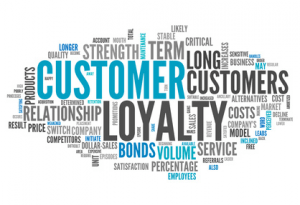How To Inspire Customer Loyalty

The internet and e-commerce shopping has massively changed the way we shop and how we look for value for money. This is evident in business today but also and probably more so when we come to spend our own money in our private lives.
Not only has internet shopping become easier thanks to the standards set by Amazon and other innovators in the space but so has the internet. When you think about devices, there are now more mobile phones and tablets in the UK than people. When you walk into any public space you will see people surfing the internet. More so in my own home, no matter what’s on the TV, someone is on their phone, shopping, chatting, researching or simply reading the news or a Kindle book. Technology has made a difference to our lives. WiFi access is common place as are 4G networks. The recent removal of mobile phone roaming charges in Europe will also add to further usage of these devices.
So what does this mean for shopping? Well quite simply, it is now easier than ever to find the goods you want and a supplier willing to ship at the lowest possible price. Retail parks used to be inundated at the weekends with ready-to-pay buyers with goods loaded into cars or delivery dates picked for items that were too bulky or stored in a national warehouse. Today, most retail shops simply provide physical viewing spaces. You research what you want and/or come across it in a shop and then go on-line to find the lowest costs supplier.
This works for standard goods that are widely available. You know the brand, the specification and that if anything goes wrong you can get the product fixed or serviced under warranty. You may buy from a known supplier brand (like Amazon as mentioned) or someone else. One thing for sure is that you will almost always check the reviews section and see what experience people have had.
For internet-based businesses customer loyalty is built on ease of use of the e-commerce website, delivery of goods on time, value for money goods and also well-structured back-office procedures for returns, customer questions and even complaints about damage in transit and so on.
Where this approach may be less than ideal, is where some element of the buying process requires value added in terms of service. In the promotional gifts industry we can think about two types of products. Plain stock items that require no branding and branded products with applied imprint.
Plain stock items are as the name suggests unbranded and can be purchased for immediate use from off-the-shelf suppliers. The issue is one of quality and price is a natural reflector of this. Check out the reviews for the company and try to go for an established company. Many promotional companies provide products plain stock, with payment via a credit card and phone call or e-commerce checkout on their website.
Branded products carry an imprint area and the process of buying online and uploading artwork may be automated to a degree. The selection of the right product for the client campaign and budget, colour choice, material and imprint design and application are areas where companies like Redbows Ltd provide their own ‘value added’ element. Based on our years of experience and knowledge, we manage this process for our clients and then make sure the goods arrive on-time, sometimes to multiple destinations.
So what does this mean for client loyalty? Well when a buying process is fully automated and works smoothly, with goods delivered on-time, clients will generally repeat an order or at least go back to the original supplier as a first ‘port of call’ when looking for more products to buy. The same is true when there is a value added service element like design, imprint application or logistics.
Companies that get the complete buying process right can experience a high degree of repeat clients. They develop and build their customer’s loyalty to the company. Each order and transaction is an investment in the brand building process.
We have all had both good and bad customer service across a number of industries. Here are some interesting facts on customer service:
- Companies only hear from less than 5% of their dissatisfied clients. Few people stand up and complain when they are dissatisfied. This is sometimes a ‘British thing’ and perhaps we need to be more demanding.
- Almost 80% of clients bail out of a transaction or intended purchase at the last minute because of a previous poor experience. We always think about giving someone a second chance but at the end of the day the original poor service is a constant reminder that we don’t fully trust the supplier.
- On average loyal clients are worth up to 10% of their original order value. This is known as the lifetime customer value. Get a client and keep them is a classic way to build a business. It’s not rocket science.
- You’ve 60-70% more chance to sell to an existing client than a new one. New clients are hard to get on board but once on they know you. Get it right the first time with a new client and you’re already on your way to making a second, third or more sale to them.
- It takes up to 12 positive order experiences to make up for a single bad one. Get it wrong and you’ve a lot of work to do to get the client back on board and ‘loyal’. It’s also very expensive to get new clients on board and sometimes as much as 50-70% as expensive as servicing an existing one.
If you have clients you are in the people business. That’s the key takeaway for anyone in business. Treat others as you would want to be treated yourself. Give them time, a smile and look after them and you will build a great business and loyal customer base.
I feel very blessed at Redbows as we have one of the highest customer retention and repeat order rates in the business. Why? Because we treat clients as we want to be treated, providing excellent value for money and great service.













